Plume de Ville
Libellules.
°°°°°°°°°°°°°°°°°°°°°°° °
May 2009
May 5
The big
damselfly
The
Banded
Demoiselle.
[Calopteryx splendens -
Odonata---Zygoptera Calopterygidae-] (Caloptéryx
éclatant)
Big zygoptera (45-50mm), even larger than some anisoptera as orthetrum.
Here the night blue male, with its large rounded wings, with very dark blue bars.
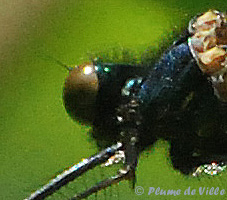
His eyes
are milky coffee, a young male.
He loves sunny and not too swift streams.
The calopteryx are the only dragonflies with coloured wings in France.
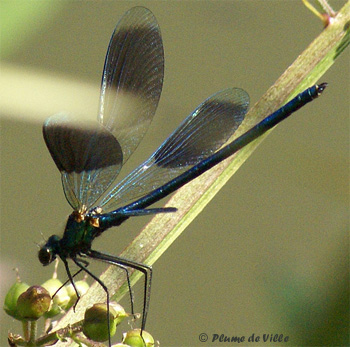
The extent
of dark bars may vary between regions and individuals. In France the
bands are
relatively narrow.
Body blue-green or blue.
This is an individual of July in defence position, raised abdomen; we
see its
blue bars with sharp borders.
[Ph. 150708]
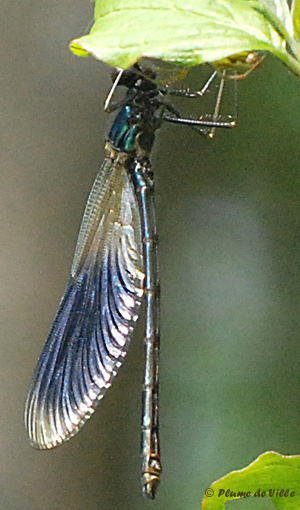
This
beautiful male arrived and hung to a leaf.
Latter, examining the series of
photos, it appeared, hidden under the leaf, the
spider Tetragnatha (?) with long legs, see the left photo top right
just under
the leaf in the legs of the dragonfly.
Tetragnatha which ten seconds later runs away!
Finally, maybe not the whole spider. It is possible that it lost a leg
and
that the dragonfly spotted it under its leaf. In any case, it didn't
lingered.
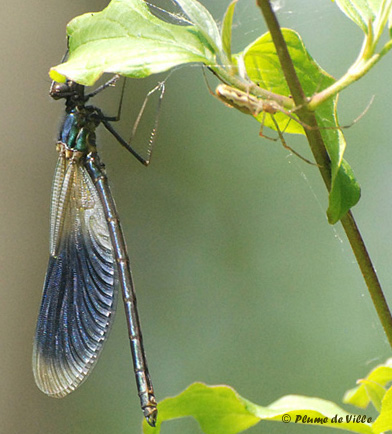
And close?
At the top, it looks like the leg of the spider in the mandibles of our
demoiselle of impressive profile.
The female.
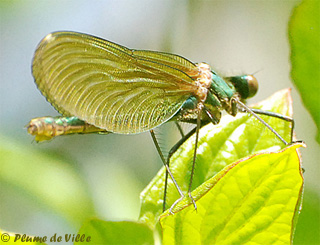
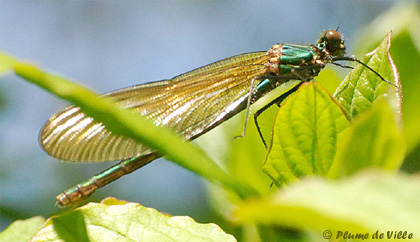
[Uncertainties
for this female. Indeed, the female Splendens is not easy to
differentiate from
the Virgo (Beautiful demoiselle). North of the Loire, as is the case here, we
have only these two
options.
Normally the wings are green and quite transparent, non brown tinted.
Above, on
the first picture, they are more in honey tones. But here too there may
be
variations. And ariations also dues to the background, to light and
glare in
pictures. If we add that the females can sometimes develop the
coloration of
males...
Virgo wings are much wider than Splendens's, but it is not obvious to
spot,
especially in wings folded together like this.
In the photos just above, the wings of the latter are nevertheless very
transparent, the wings network is dense; and above at right, it is in
tones
more green (and not "tobacco" or "smoked" as Virgo is described),
with a green costal nervure. We see its clear
pseudoptérostigmas well
positioned well towards the extremity of the wing.
This is the only observed female. Last but not least, there were only
male Splendens around.]
(Ph.210409 Plaine de Sorques)
http://www.blog.libellulesmaizieres.fr/2008/02/22/calopteryx-splendens-ou-calopteryx-virgo/
http://odonates22.chez-alice.fr/zygopteres/calopteryx_eclatant/calopteryx_eclatant.html
http://www.galerie-insecte.org/galerie/calopteryx_splendens.html
http://www.dragonflysoc.org.uk/caspl.html
25 May
Gilt
encounter.
.
A small
shallow
pond in the sunshine, a few tufts of yellow iris on the banks and
perched on a leaf,
close enough to the water, a golden jewel.
Broad-bodied Chaser [Libellula depressa - Libellulidae -] (Libellule
déprimée)
It takes its French name from its abdomen short, broad and flattened.
This young immature female has just hatched and waits for its wings to dry and solidify.
She went out for some time because its wings are already deployed, transparent and not crumpled.
It hold them still in alignment with its body and not spread and
horizontal as
is proper for an Anisoptera.
His larva
costume is this grey
dress that she abandoned (exuviae). She has just completed its final
moult
(imaginal moult).
The larvae breathe in the water and in the air by their
tracheobranchia. The
small white threads that we see here are the tracheae. The skin was
split on
the back and it came out slowly (too bad, before we arrived).
Its exuviae was a little lower on the next leaf touching teh one in
which the
dragonfly is perched.
It
will
graduallyspread its wings.
This
medium-size
dragonfly is 4-5 cm long. At the base, its fore wings have large bar
shaped dark
spots, and triangle shaped for the hind wing. Two whitish bands are
visible on
the thorax.
Gradually
its
wings spread.
30mn later, the wings are horizontal. Voila, it is ready for its dragonfly life but that is another story...
20
minutes later she was still there, but I had to leave before the flight
and
do not know at what time it flew.
Older, it will lose its beautiful honey colour and will take a
yellow-brown
hue.
(Ph. Seine et Marne 190509)
26 May
Blue and
gold, dragonfly life.
Next day on
the same pond, perched on an overhanging twig over the pond, here in
blue, Mr Broad-bodied
Chaser.
Well
in
sight, it waits under the sun, clearly visible to all.
Friends and foes alike.
Blue, all blue. It is a
mature male. In the beginning, it is yellow as his immature female.
It
covers
gradually with a powdery blue film: a yellow stripe is still visible on
the
side of the abdomen of this one.
The dark
spots at the base of the wings and the white markings of the thorax are
apparent.
From time to time it does dazzling flights over its pond in pursuit of
a rival.
A few zigzags, the intruder escorted out, it alights on the same spot,
patiently.
Twenty
minutes later, I decided to leave it and its hopes alone when a female
enters
his territory, the male responds instantly and immediately grabs her.
We hear
the sizzling of the wings, the noise characteristic when large
dragonflies wings
touch in flight.
Mating takes place immediately in flight. The picture is poor, but the
flight
is fast and difficult to follow. We distinguish the legs of the female
which holds
the male.
Mating
is
brief and the female will lay eggs immediately.
It stays hovering over an area and then descends into the water,
abdomen
vertical.
She lays an egg and goes
back up vertically, then again, back to touch the water with her
abdomen
vertical. It goes very fast (hence the low quality of the photo) and
does a
short hover from time to time, while the male patrols aggressively
around her.
Four minutes later, it has finished and fly away. The male resumes its patient guard on its branch.
27 May
Large
Red
Damselfly.
[Pyrrhosoma nymphula - Coenagrionidae -] (Petite Nymphe au
corps de feu)
Tiny
zygoptera (lady, their four wings are identical) of 3 cm, bright red,
very
active, with black legs. These beautiful damselflies can be approached
without
difficulty.
Black
pterostigmas. Red eyes.
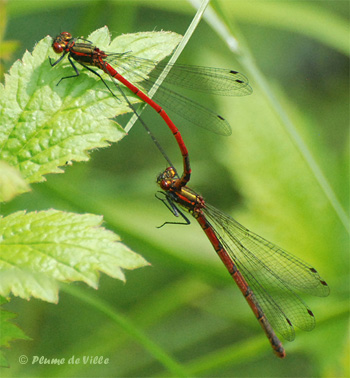
Since late
April and early May I met a lot in tandem pairs near the spawning
grounds.
The male has
the abdomen red and black bands at the end of the abdomen. The
coloration of the females may vary and include varying degrees of red,
even to
red-less variant. Bands in the thorax (antehumeral) wide and red in
adults.
The
male
holds the female during spawning. Below the male has the legs folded,
it flutters.
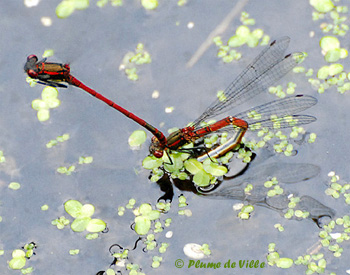
There are
crowds on the spawning grounds. And even a little traffic jam. Little
mistake
of drivers, which is the proprietary one?
Spawning in
group. The abdomen of the female is deeply immersed in water under a
twig or duckweed
where it will drill a hole and insert the egg.
Encountered
in pools of stagnant water with a beautiful vegetation.
And then
there are the contortionists.
This one alighted with a straight abdomen and a suddenly bending it in
this
strange way; one can almost hear a click.
All
those exercises
starve! At the expense of the spider...
The last
one... because it has well chosen the background isn't?
(Ph. Seine et Marne, Vincennes 0509)


